Gemini constellation is located in the northern celestial hemisphere. Its name means “the twins” in Latin. The constellation represents the twins Castor and Pollux (Polydeuces), also known as the Dioscuri in ancient times, in Greek mythology.
Gemini is one of the zodiac constellations, first catalogued by the Greek astronomer Ptolemy in the 2nd century. The constellation’s symbol is ♊.
Gemini is known mainly for its two bright stars, Castor and Pollux, the neutron star Geminga, and several notable deep sky objects, among them the open cluster Messier 35, the Eskimo Nebula, the Jellyfish Nebula, and the Medusa Nebula.
Facts, location and map
Gemini is the 30th largest constellation in the sky, occupying an area of 514 square degrees. It lies in the second quadrant of the northern hemisphere (NQ2) and can be seen at latitudes between +90° and -60°. The neighboring constellations are Auriga, Cancer, Canis Minor, Lynx, Monoceros, Orion and Taurus.
The constellation name Gemini is pronounced /ˈdʒɛmɪnaɪ/. In English, the constellation is known as the Twins. The genitive form of Gemini, used in star names, is Geminorum (pronunciation: /ˌdʒɛmɪˈnɒrəm/). The three-letter abbreviation, adopted by the International Astronomical Union (IAU) in 1922, is Gem.
Gemini belongs to the zodiac family of constellations, along with Aries, Taurus, Cancer, Leo, Virgo, Libra, Scorpius, Sagittarius, Capricornus, Aquarius and Pisces.
Gemini contains a Messier object – the star cluster Messier 35 (M35, NGC 2168) – and has seven stars with known planets. The brightest star in the constellation is Pollux, Beta Geminorum, with an apparent magnitude of 1.14. There are two meteor showers associated with the constellation; the Geminids and the Rho Geminids. The Geminids are usually bright and peak around December 13-14.
Gemini contains 10 named stars. The star names approved by the International Astronomical Union (IAU) are Alhena, Alzirr, Castor, Geminga, Jishui, Mebsuta, Mekbuda, Pollux, Propus, Tejat, and Wasat.
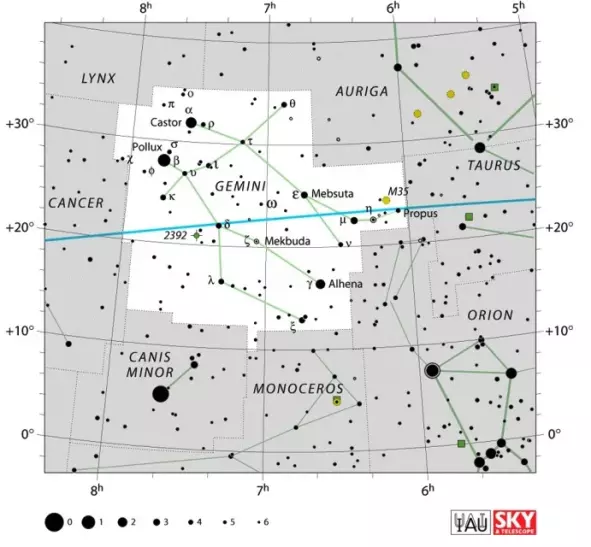
Gemini constellation map by IAU and Sky&Telescope magazine
Myth
Gemini constellation represents the twins Castor and Polydeuces in Greek mythology. The brothers were also known as the Dioscuri, which means “sons of Zeus.” In most versions of the myth, however, only Polydeuces was Zeus’ son, and Castor was the son of the mortal King Tyndareus of Sparta.
The twins’ mother, Spartan Queen Leda, was seduced by Zeus, who visited the queen in the form of a swan, associated with the constellation Cygnus (the Swan), and she became pregnant with Polydeuces and Helen (who would become the famous Helen of Troy). Leda later also became pregnant with Castor and Clytemnestra (who would later marry Agamemnon). Castor and Clytemnestra were fathered by Tyndareus and, unlike Zeus’ children, they were mortal.
Castor and Polydeuces grew up together and were very close. Castor was an excellent horseman and proficient at fencing – he is said to have taught Heracles himself to fence – and Polydeuces was famed for his boxing skills. The two were part of the Argonauts’ expedition to get the Golden Fleece. Polydeuces’ boxing skills came in handy when Amycus, a son of Poseidon who ruled Asia Minor, refused to let the Argonauts leave until one of them fought him in a boxing match. Polydeuces accepted the challenge and easily won.
The twins came to the crew’s rescue on a number of occasions. They have been known as the patron saints of sailors, and were said to have been given the power to rescue sailors who were shipwrecked by the sea god Poseidon himself, who also gave them two white horses, which the twins often rode.
The Dioscuri are associated with St. Elmo’s fire, an electrical phenomenon that occurs during thunderstorms, when a coronal discharge from a pointed object in a strong electric field creates luminous plasma. The phenomenon is named after another patron saint of sailors, St. Erasmus of Formiae. St. Elmo’s fire would appear to sailors as a glowing ball of light during thunderstorms and they considered it as a sign that their guardian saint was with them.
In the myth, Castor and Polydeuces clashed with Idas and Lynceus, who were also twins and former Argonauts, over two women, Phoebe and Hilaera, who were engaged to the latter. Castor and Polydeuces were drawn to the women and carried them off. Idas and Lynceus pursued and caught up with the twins. Castor met his end at Idas’ hands and Polydeuces did away with Lynceus. When Idas tried to avenge his brother, Zeus intervened and sent a thunderbolt which saved his son. Polydeuces asked Zeus to share his immortality with his brother and the god placed them both in the sky, where they remain inseparable as the constellation Gemini.
The two brightest stars in the constellation, Alpha and Beta Geminorum, mark the twins’ heads.
Not everyone identified the constellation as Castor and Polydeuces in ancient times. Hyginus and Ptolemy associated the two stars with Apollo and Heracles, who were half-brothers and both sons of Zeus.
Major stars in Gemini
Castor – α Geminorum (Alpha Geminorum)
Castor is the second brightest star in Gemini and the 44th brightest star in the sky. It is a visual binary with a combined apparent magnitude of 1.58. The two components are separated by 6” and have a revolution period of about 467 years.
Each component of the Alpha Geminorum system is in itself a spectroscopic binary star, which makes Castor a four-star system. Castor also has a faint companion about 72” away, an eclipsing binary star system with a period of just under a day.
Both components of the system are red (class M) dwarfs. This makes Castor a sextuple star system, as all six of its components are gravitationally bound together. The third component is classified as a variable star and has the designation YY Geminorum.
The primary component belongs to the spectral class A1 V and its companion is believed to be of spectral type M5 V. The stars of the secondary component have the stellar classifications A2 Vm and M2 V.
Castor is approximately 51 light years distant from the Sun. In Arabic culture, it was known as “The Head of the Foremost Twin,” or Al-Ras al-Taum al-Muqadim.
Pollux – β Geminorum (Beta Geminorum)
Pollux is the brightest star in Gemini and the 17th brightest star in the night sky. It is an evolved orange giant with the stellar classification K0 III. It has an apparent magnitude of 1.14 and is 33.78 light years distant from the solar system.
Beta Geminorum has twice the Sun’s mass and about nine times the solar radius. It is sometimes known as “The Head of the Second Twin,” from the Arabic Al-Ras al-Tau’am al-Mu’akhar.
An extrasolar planet was confirmed to be orbiting the star in June 2006. The planet, Pollux b, has a mass at least 2.3 times that of Jupiter and an orbital period of 590 days.
Alhena – γ Geminorum (Gamma Geminorum)
Alhena, Gamma Geminorum, is another bright star in Gemini. With an apparent magnitude of 1.915, it is easily visible to the unaided eye. The star is approximately 109 light years distant from Earth.
Gamma Geminorum is a white subgiant star with the stellar classification A1 IV, It has 2.8 solar masses and 3.3 times the solar radius. It is about 123 times more luminous than the Sun.
The star’s traditional name, Alhena, comes from the Arabic Al Han’ah, which means “the brand,” referring to the brand on a camel’s neck. It is also sometimes known as Almeisan, which is derived from the Arabic Al Maisan, which means “the shining one.”
Mebsuta – ε Geminorum (Epsilon Geminorum)
Epsilon Geminorum marks Castor’s outstretched right leg. It is a supergiant belonging to the spectral class G8 Ib. It has an apparent magnitude of 3.06 and is approximately 840 light years distant.
The star is about 8,500 times more luminous than the Sun and has 19 times the solar mass. The star’s radius is around 105-175 times that of the Sun.
Epsilon Geminorum’s traditional name, Mebsuta, comes from the ancient Arabic Mabsūṭah, which means “the outstretched paw.” In Arabic culture, Epsilon and Zeta Geminorum represented the paws of a lion. Epsilon Geminorum is also sometimes called Melboula or Melucta.
The star lies close to the ecliptic and can be occulted by the Moon and planets.
Tejat – μ Geminorum (Mu Geminorum)
Mu Geminorum is the fourth brightest star in the Gemini constellation. It has a visual magnitude of 2.857 and is about 230 light years distant. The star belongs to the spectral class M3 III, which means that it is a red giant. It is also classified as a slow irregular variable of type LB. It exhibits variations in luminosity between magnitude 2.75 and 3.02 over a period of 72 days, and has a period of 2,000 days of long term variation.
The star’s traditional name, Tejat Posterior, means “the back foot,” and it refers to Castor’s foot. It is also sometimes known by another Latin name, Calx, which means “the heel.”
Propus – η Geminorum (Eta Geminorum)
Eta Geminorum is a multiple star approximately 350 light years from Earth. It consists of three components, a spectroscopic binary star and class G0 dwarf star that orbits the pair with a period of over 700 years.
The primary component of the binary system is a semi-regular variable star exhibiting variations in luminosity over a period of 234 days. It is a a red giant with the spectral classification M3IIIlab. Its brightness ranges between magnitude 3.15 and 3.9. The secondary star is of the spectral type B and orbits the red giant with a period of 8.2 years.
Eta Geminorum is located near the ecliptic and can occasionally be occulted by the Moon and very rarely by a planet.
Alzirr – ξ Geminorum (Xi Geminorum)
Xi Geminorum is a yellow-white subgiant star belonging to the spectral class F5 IV, about 11 times more luminous than the Sun. It has an apparent magnitude of 3.35 and is 58.7 light years distant from Earth. The star is a rapid rotator, with a projected rotational velocity of 66 km/s. It is suspected to be a spectroscopic binary.
The star has a proper name, Alzirr, which means “the button” in Arabic. It marks one of the four feet of the Gemini twins. It is bright enough to be seen without binoculars.
Wasat – δ Geminorum (Delta Geminorum)
Delta Geminorum is also bright enough to be visible to the unaided eye. It has a visual magnitude of 3.53 and is about 60.5 light years distant. It has the stellar classification F0 IV, which means that it is a yellow-white subgiant star.
The star’s traditional name, Wasat, means “middle” in Arabic. The star is also sometimes known by its Chinese name, Ta Tsun.
Wasat is located two-tenths of a degree south of the ecliptic and is sometimes occulted by the Moon and much less frequently by planets. In 1930, American astronomer Clyde Tombaugh discovered Pluto only 0.5° to the east of the star.
Wasat is a very fast rotator, with a projected rotational velocity of 129.7 km/s. It is believed to be about 1.6 billion years old. In 1.1 million years, the star will come within 6.7 light years of the Sun.
Delta Geminorum is really a triple star system. The inner stars in the system form a spectroscopic binary with components orbiting each other with a period of 6.1 years. The binary system has a class K companion that orbits the primary component with a period of 1,200 years and can be seen in a small telescope.
κ Geminorum (Kappa Geminorum)
Kappa Geminorum is another multiple star in Gemini. It has the stellar classification G8 IIIa and is approximately 143 light years distant from the solar system. The star is 78 times more luminous than the Sun. It has an apparent magnitude of 3.57.
λ Geminorum (Lambda Geminorum)
Lambda Geminorum belongs to the spectral class A3 V and is classified as a variable star. It has an apparent magnitude of 3.58 and is 94.3 light years distant. It is 28 times more luminous than the Sun, has 2.8 times the solar radius, and 2.1 times the Sun’s mass.
The star’s estimated age is around 800 million years.
ι Geminorum (Iota Geminorum)
Iota Geminorum is a fourth magnitude star belonging to the spectral class G9III. It has an apparent magnitude of 3.78 and is approximately 326 light years distant.
The star’s traditional name, Propus, means “the forefoot” in Latin. Propus is classified as a variable star.
Mekbuda – ζ Geminorum (Zeta Geminorum)
Mekbuda, Zeta Geminorum, is an intermediate luminosity supergiant and a variable star classified as a Classical Cepheid, or Population I Cepheid, named after Delta Cephei, the star that serves as the prototype for this class of variables. Delta Cephei variables are generally 4-20 times more massive than the Sun and can be up to 100,000 times more luminous. They are usually yellow supergiants belonging to the spectral class F6-K2 and they exhibit variations in brightness as a result of pulsation periods lasting from a few days to months.
Zeta Geminorum, like other stars in this class, has a regular pulsation frequency, one determined by the star’s mass. Its luminosity varies over a period of 10.148 days and ranges from magnitude 3.68 to 4.16. The star is about 2,900 times more luminous than the Sun.
The star’s proper name, Mekbuda, comes from ancient Arabic and means “the lion’s folded paw.”
τ Geminorum (Tau Geminorum)
Tau Geminorum is an orange giant with the stellar classification K2 III. It has an apparent magnitude of 4.42 and is approximately 321 light years distant from the solar system. The star can be seen without binoculars under good conditions.
Tau Geminorum has twice the Sun’s mass and 27 times the radius. It is about 224 times more luminous.
The star has a brown dwarf, Tau Geminorum b, with 18.1 Jupiter masses, for a companion. The dwarf star, discovered in 2004, takes 305 days to complete an orbit around the primary star.
U Geminorum
U Geminorum is a dwarf nova in Gemini. It is a binary star composed of a white dwarf that closely orbits a red dwarf star. About every 100 days, the star has an outburst and this causes a dramatic increase in luminosity. The system was discovered by the English astronomer John Russell Hind in 1855, when the star had one of its outbursts.
The two dwarfs have an orbital period of 4 hours and 11 minutes, which is very short and the main reason why U Geminorum is a variable star. The stars eclipse each other with each revolution. Usually, the system has an apparent magnitude that varies from 14.0 to 15.1, but during an outburst, the system can reach 9th magnitude, making it 100 times brighter. The period is very irregular, between 62 and 257 days.
U Geminorum is approximately 400 light years distant from the Sun.
Deep sky objects in Gemini
Messier 35 (NGC 2168)
Messier 35 is an open star cluster in Gemini. It covers an area of the sky as big as the full Moon. The cluster has an apparent magnitude of 5.30 and is approximately 2,800 light years distant from Earth.
It was discovered by the Swiss astronomer Philippe Loys de Chéseaux in 1745 and later independently discovered by English doctor and astronomer John Bevis before 1750.
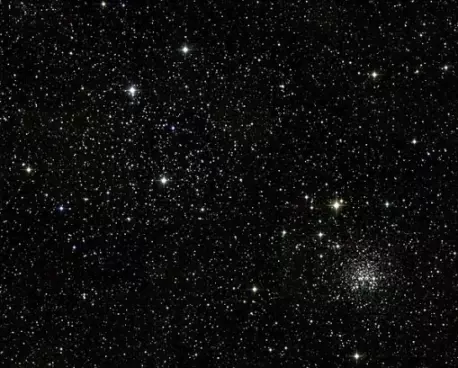
Messier 35, Atlas Image mosaic courtesy of 2MASS/UMass/IPAC-Caltech/NASA/NSF
NGC 2158
NGC 2158 is another open cluster in Gemini. It lies southwest of Messier 35. The cluster has an apparent magnitude of 8.6 and is approximately 11,000 light years distant from the Sun. It is believed to be about a billion years old.
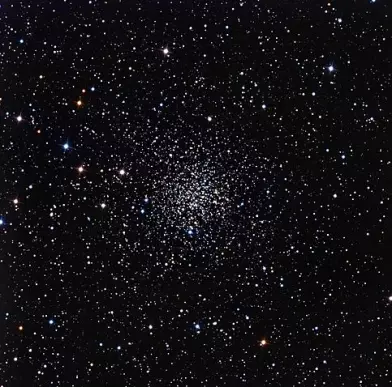
NGC 2158, image: Adam Block/Mount Lemmon SkyCenter/University of Arizona (CC BY-SA 3.0 US)
Eskimo Nebula (NGC 2392, Caldwell 39)
The Eskimo Nebula is a bipolar double-shell planetary nebula in Gemini. It was discovered by the German-born British astronomer William Herschel on January 17, 1787, who thought it was a “star 9th magnitude with a pretty bright middle, nebulosity equally dispersed all around.”
The nebula is surrounded by a layer of gas that used to form the outer layers of a star similar to the Sun. It is sometimes also called the Clown Face Nebula.
NGC 2392 can be observed in a small telescope. It has an apparent magnitude of 10.1 and is at least 2,870 light years distant from the solar system.
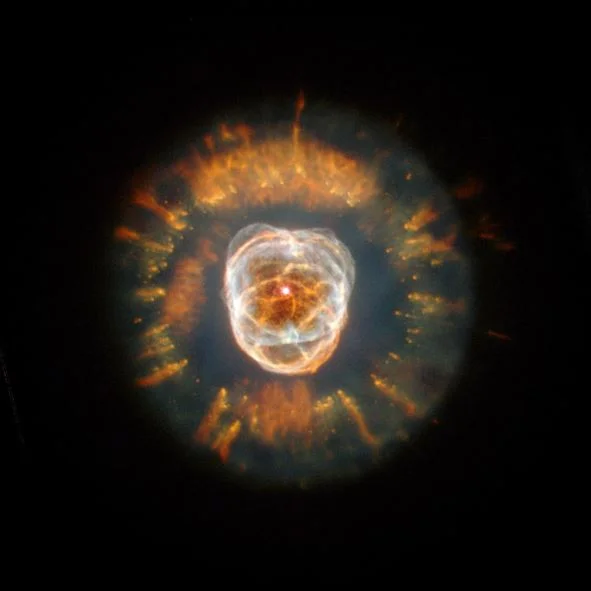
Eskimo nebula (NGC 2392). In its first glimpse of the heavens following the successful December 1999 servicing mission, NASA’s Hubble Space Telescope captured a majestic view of a planetary nebula, the glowing remains of a Sun-like star in its final stages. This stellar relic, first spied by William Herschel in 1787, is nicknamed the “Eskimo” Nebula (NGC 2392) because, when viewed through ground-based telescopes, it resembles a face surrounded by a fur parka. In this Hubble telescope image, the “parka” is really a disk of material embellished with a ring of comet-shaped objects, with their tails arching away from the central star. The Eskimo’s “face” also contains some fascinating details. Although this bright central region resembles a ball of twine, it is, in reality, a bubble of material being blown into space by the central star’s intense “wind” of high-speed material. Image: NASA, ESA, Andrew Fruchter (STScI), and the ERO team (STScI + ST-ECF)
Jellyfish Nebula – IC 443 (Sharpless 248)
IC 443 is a Galactic supernova remnant in Gemini. It is also known as the Jellyfish Nebula. The nebula is approximately 5,000 light years from Earth. It can be found near the bright star Eta Geminorum.
The Jellyfish Nebula is believed to be a remnant of a supernova that occurred 3,000-30,000 years ago. It is about 70 light years in size.
The supernova event that resulted in the creation of the nebula also created a neutron star, and it is believed to have been a Type II supernova, a dramatic end of a massive progenitor star.
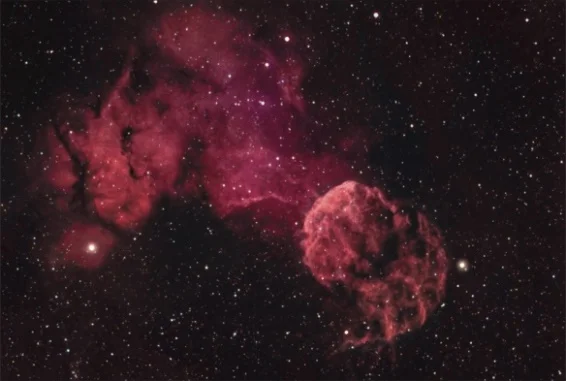
IC 443 wide field image. The stars η (right) and μ (left) Geminorum, the diffuse emission from S249 (north), and the G189.6+3.3 partial shell (center) are visible. Image: Giovanni Benintende (CC BY-SA 3.0)
Medusa Nebula
The Medusa Nebula (Sharpless 2-274, Abell 21) is a planetary nebula in the Gemini constellation, located near the border with Canis Minor. The nebula is quite old and quite large, more than four light years across.
It got the name Medusa because the filaments of glowing gas are evocative of the serpent hair of the Gorgon Medusa, a monster from the myth of Perseus whose gaze would turn people to stone.
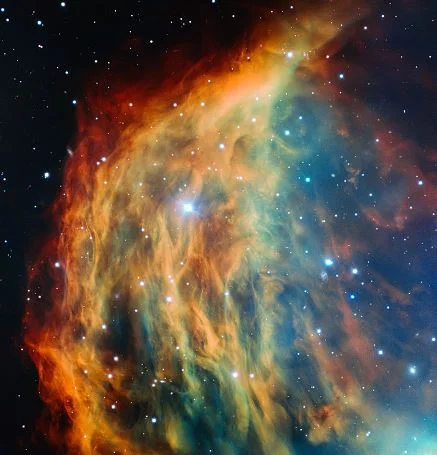
ESO’s Very Large Telescope in Chile has captured the most detailed image ever taken of the Medusa Nebula (also known Abell 21 and Sharpless 2-274). As the star at the heart of this nebula made its final transition into retirement, it shed its outer layers into space, forming this colourful cloud. The image foreshadows the final fate of the Sun, which will eventually also become an object of this kind. Image: European Southern Observatory (CC BY 4.0)
The nebula was first discovered by UCLA astronomer George O. Abell in 1955.
It was believed to be a supernova remnant until the 1970s, when Soviet astronomers confirmed it was most likely a planetary nebula. The nebula was formed when a red giant turned into a hot white dwarf and shed its outer layers.
The Medusa Nebula has an apparent magnitude of 7.68 and is approximately 1,500 light years distant from the solar system. It has a low surface brightness, between 15.99 and 25, and it takes at least an 8-inch telescope with an OIII filter to find it.
Geminga
Geminga is a neutron star in the Gemini constellation, a decaying core of an old massive star that ended its life as a supernova about 300,000 years ago. Its name is derived from the Italian gh’è minga, which means “it’s not there,” and at the same time it is short for “Gemini gamma-ray source.” The star has an apparent magnitude of 25.5 and is approximately 815 light years distant from the Sun.
Geminga was the first unidentified gamma-ray source to be discovered, as well as the first example of a radio-quiet pulsar. It was originally detected as a source of a significant excess of gamma-rays by the SAS-2 satellite (Small Astronomy Satellite 2), NASA’s gamma ray telescope.
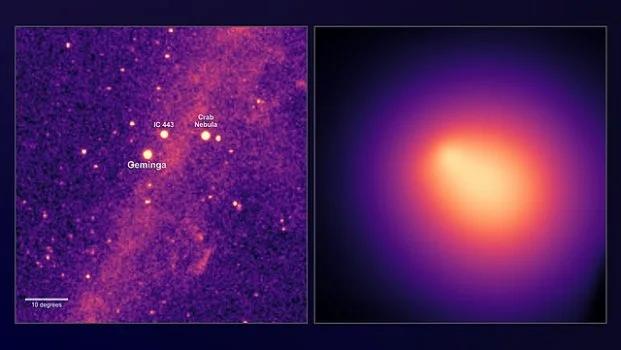
These images show a region of the sky centered on the pulsar Geminga. Left: The total number of gamma rays detected by Fermi’s Large Area Telescope at energies from 8 to 1,000 billion electron volts (GeV) — billions of times the energy of visible light — over the past decade. Brighter colors correspond to greater numbers of gamma rays. Right: By removing all bright sources, astronomers discovered the pulsar’s faint, extended gamma-ray halo. Credit: NASA/DOE/Fermi LAT Collaboration
NGC 2129
NGC 2129 is a young open cluster in Gemini. It has a visual magnitude of 6.7 and is approximately 7,200 light years distant from the Sun. The cluster is located inside the Local spiral arm, a minor spiral arm of the Milky Way. It is estimated to be only 10 million years old.
The brightest stars in the cluster are two close B-class stars that share the same radial velocity and proper motion, and are believed to form a binary system.
NGC 2371-2
NGC 2371-2 is a planetary nebula in Gemini. It is a dual lobed nebula, one that looks like it could be two different, separate objects. This is why it has two entries in the New General Catalogue, NGC 2371 and NGC 2372.
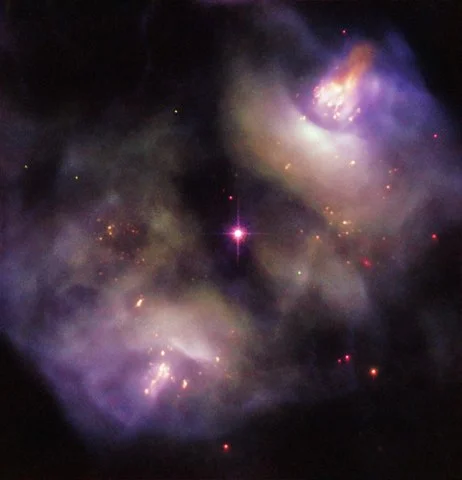
NGC 2371-2, image: ESA/Hubble & NASA, R. Wade et al.
The nebula was discovered by William Herschel. It has an apparent magnitude of 13 and is approximately 4,400 light years distant from Earth. It appears southwest of Castor and is visible in an amateur telescope. It is one of the objects included on Royal Astronomical Society of Canada’s (RASC) Finest NGC Objects list.
NGC 2355
NGC 2355 is an open cluster composed of old stars. It has a visual magnitude of 9.7 and is approximately 5,400 light years distant. The cluster is believed to be a billion years old.
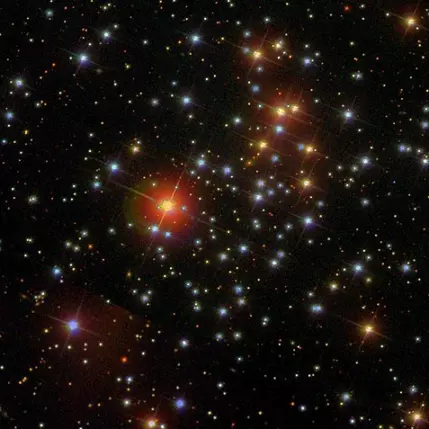
NGC 2355, image: Sloan Digital Sky Survey